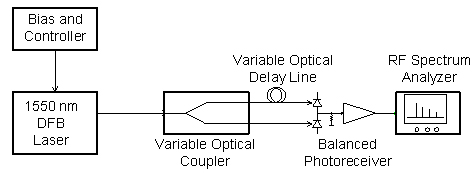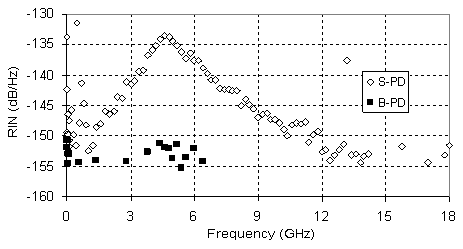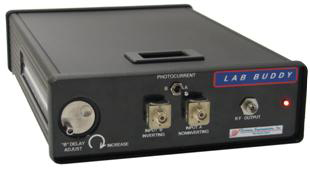|
|

|
Ewing, NJ - July 20, 2006
In applications where a low level optical signal is combined with the signal of a high power laser, intensity fluctuations (relative intensity noise or RIN) of the high power laser signal often degrades the system performance. This common-mode noise can be eliminated by means of a balanced photodetector(1). The setup to measure RIN is given in fig. 1.

Fig. 1: Experimental setup to measure the impact of relative intensity noise induced by a DFB laser using single-ended and balanced detection
To demonstrate high RIN levels, the distributed feedback laser (DFB) laser is operated at low output power (2.5 dBm) generating RIN values of up to 130 dB/Hz. The output signal of the laser is fed to a variable ratio optical coupler. The two outputs of the couplers are connected to the inputs of a balanced photodetector. The variable optical delay line is used to guarantee the same path length for the input signals into the balanced photodetector. By adjusting the coupling ratio from 50/50 to 0/100, balanced and single-ended detection can be achieved with this setup. The signal out of the photodetector is electrically amplified and measured with an RF spectrum analyzer. The result of this measurement setup is shown in fig. 2. Balanced detection allows the RIN levels to reduce from 130 dB/Hz by at least 20 dB to levels of 150 dB/Hz over a bandwidth of 18 GHz. The results of fig. 2 demonstrates the good common-mode rejection (35 dB) of the balanced detector.

Fig. 2:Measured RIN values of DFB laser with 2.5 dBm output power for single-ended and balanced detection. It can be seen that RIN values of 130 dB/Hz can be reduced to levels below 150 dB/Hz over a bandwidth of 18 GHz
For the above RIN measurement and cancellation technique, Discovery offers a “Plug & Play” Balanced Photodiode Instrument as shown in fig. 3 below.

Fig. 3: Balanced Photodiode Lab Buddy with integrated Variable Optical Delay Line
(1) A. Joshi, D. Becker, C. Wree, and D. Mohr, “Coherent Optical Receiver System with Balanced Photodetection,” Proceedings of SPIE Vol. 6243, online pp. 62430E-1-62430E-14, 2006.
Discovery Semiconductors is an industry leader in manufacturing ultrafast, high optical power handling InGaAs photodetectors, radio frequency over fiber optical receivers, balanced optical receivers and several other custom products for applications ranging from analog RF links to ultrafast digital communications. They have experience with Space and High Reliability Military Projects, and their customers include Fortune 500 telecom and aerospace companies, defense organizations, universities and emerging communication companies.
For additional information, including complete product specifications, operational capabilities and pricing, or to discuss your application in detail, please call Discovery at: (609) 434-1311 or fax: (609) 434-1317.